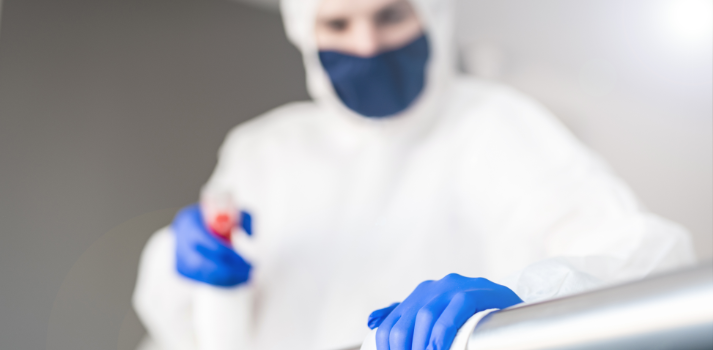
The current Covid-19 crisis has led different sectors to adapt their practices to the situation. They have had to implement various sanitary measures to ensure the health and safety of employees, including a reinforcement of the cleaning and disinfection plans.
How to set up these cleaning/disinfection plans?
This article will guide you through the process.
SARS-CoV-2 does not multiply in the environment; however, it can persist for several days on some surfaces. According to the World Health Organization (WHO), the virus can survive 72 hours on plastic and stainless steel, less than 24 hours on cardboard, and less than 4 hours on copper.
It is, therefore, essential to ensure the effective Disinfection of your surfaces to prevent the virus from persisting on them.
Cleaning, Disinfection. What's the difference?
The cleaning process removes dirt (grease, dust, etc.) for a physically clean surface. The surfactant present in cleaning products (soaps, detergents, degreasing agents, detergents, detergents) can solubilize the lipids of the virus envelope and inactivate it.
In the case of Disinfection, according to the definition of the AFNOR (the French national organization for standardization and its International Organization for Standardization member body, NF T72-101):
Disinfection is the operation with a quick result that kills or eliminates micro-organisms and/or inactivates undesirable viruses carried on contaminated inert media, depending on the objectives set. The result of this operation is limited to the microorganisms present at the time of the operation.
In the case of the SARS-CoV-2 virus, you can carry out a Disinfection in addition to cleaning. Also, for a given product to be considered as having virucidal activity, it must meet the criteria of standard NF EN 14476.
What products can I use in the case of the Covid-19 outbreak?
On the INRS (The French Institute for Research and Security) site, several substances have been identified in the context of the current Covid-19 epidemic:
- - sodium hypochlorite (bleach) with 0.1% active chlorine;
- - hydrogen peroxide (hydrogen peroxide) at 0.5%;
- - 70% ethanol;
- - 70% isopropanol.
The combination of cleaning and Disinfection, as defined above, is essential. If the surface is not previously cleaned, the active chlorine present in the bleach will bind to the organic matter present. It will no longer be available in sufficient quantities to disinfect the surface in question adequately.
Cleaning and disinfection products must, therefore, be chosen methodically: in the case of SARS-CoV-2, these are the products mentioned above. The packaging must be adapted, and dedicated protocols must rigorously control the dilutions (if necessary).
The persons in charge of cleaning/Disinfection must have been previously trained on the risks involved and must have suitable protective systems (protective glasses, work clothes with long sleeves and legs, etc.).
How should I organize my cleaning/disinfection plan?
Environment (premises/surfaces)
On the French government website, there is more information on the application of cleaning/disinfection processes concerning deconfinement. It all depends on the risk of contamination of the surface in question.
The higher the potential number of people in contact with the surface, the higher the risk of contamination.
When the risk of contamination of a surface is low, a simple daily cleaning may be sufficient. It all depends on the cleaning/disinfection plan established beforehand in your structure. Indeed, the cleaning/disinfection plan of a company in the tertiary sector will not be the same as that of a food-processing company. The INRS (The French Institute for Research and Security) has, moreover, published in January 2020 a guide to help you clean your premises (work surfaces, floors, walls).
Surfaces with a high risk of contamination (handles, switches, sanitary facilities, etc.) must be cleaned/disinfected several times a day. The INRS (The French Institute for Research and Security) publishes specific disinfection guides for more highly contaminated surfaces, for example for biology laboratories.
In general, employees should adopt social distancing in all structures, and the employer should ensure that Personal Protective Equipment (PPE) is made available in sufficient numbers. You should no overlook specific details. For example, consider replacing hand dryers in washrooms with single-use paper dispensers.
The HCSP (The French High Council on Public Health) reminds the importance of ventilating the premises, particularly during cleaning/disinfection operations. It also requires a periodic check of the ventilation and airing systems.
The HCSP (The French High Council on Public Health) also mentions the need to purge the internal cold and hot water networks to evacuate any volume that may have stagnated in the pipes, particularly if you have shut down the company during lockdown.
Waste sector
Concerning waste management (wipes, masks, etc.), this will depend on the sector of activity. For the hospital environment, they do have a specific department that will handle medical and infectious waste.
For other sectors of activity, they must put the waste in a closed plastic bag, which they will have to put in the household waste bag.
Working clothes
In the specific case of working clothes, their maintenance must be carried out by the employer. If the employer is paying an allowance to the employee for the upkeep of clothing, the working clothes must be brought home in a dedicated plastic bag and washed separately at 60°C with a detergent.
The employer must therefore put in place suitable hygiene procedures to ensure a safe resumption of activity. One of the measures they must organize is the review of the cleaning/disinfection plan in the context of the current epidemic.
. . .






